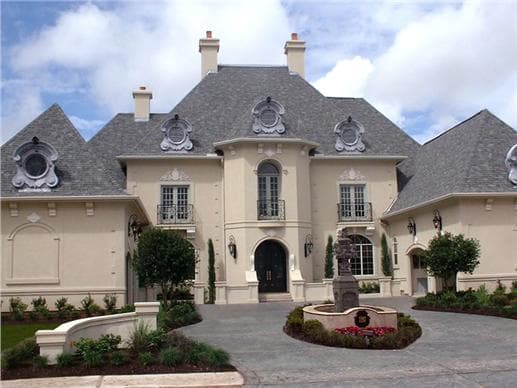Texas Modern Style – Adapted to the State’s Climate and Landscape

Architectural Modernism Expressed in the Lone Star State
Texas is not just oil and oil fields or sprawling plains, spectacular mountains and hills, and rambling ranches. The Lone Star State — with its vast terrain and some unusual topography — features residential architectural styles influenced by its natural landscape and distinct geographical elements. All around the state, you can find a wide variety of Texas house styles that range from the quintessential ranch to plantation and adobe style homes, mansions, Spanish mission designs, beachfront homes, and log cabins.
Perhaps the residential style most associated with Texas is the sprawling ranch, built on a huge property with great views of the surrounding landscape. While the original Texas modern house of the 1920s and 1930s was defined by large windows, the use of ubiquitous and inexpensive steel, as well as a certain boxiness that lent itself to tall indoor and shaded outdoor spaces where air could move more easily to cool off Texans in hot summers, today’s contemporary homes in Texas with Texas Modern styling also often incorporate more traditional home real estate styles.
Take, for instance, this 3,623-square-foot Ranch style plan with rustic touches has two bedrooms, two full baths, an unfinished basement that can be finished for additional bedrooms or an in-law suite, plus an open plan Great Room, a spacious kitchen with two islands, and other amenities perfect for living and entertaining in the Lone Star state.
You can find Texas Modern elements throughout Texas, but especially in Dallas homes. Neighborhoods like Preston Hollow, University Park, Highland Park, and Leonard Street feature a wide array of sometimes stunning examples, but it isn’t just a phase from a bygone era. New construction is going up right now in the Texas Modern style—both custom homes and pre-designed homes—not just in the Lone Star state but all over the United States. What exactly is behind the enduring appeal of this architectural style?
The History of Texas Modern
The style known as Texas Modern was first conceptualized in the 1920s and 1930s by Dallas architect David Williams, and then continued by his protégé, O’Neil Ford.
Williams, who spent a few years in Europe and studied art and interior architecture in Paris, closely observed modernist designs in Europe. He was impressed by the artisans who always used materials that were accessible and indigenous to their areas. When Williams returned home, an American innovation in residential style was emerging in the Midwest. Known as Prairie Style – it emphasized the integration of the natural surroundings with natural materials. The style and ideology impressed Williams and motivated him to develop a distinct architectural style that personified Texas.
Texas Modern draws heavily from the philosophy of European modernism and Williams’ and Ford’s vision of modern architecture. As Helen Thompson, a writer focusing on Texas architecture, describes it in an interview, Williams and Ford were interested in “...what 'modern' should look like in a state where topography, climate, and culture are powerful.” Texas Modern designs daw on the heritage of the early Texas ranch style houses, with their efficient long, low profiles “...focused on the relationship of the house to the site, the materials it is made of … and the way the building functions in the harsh Texas climate.”
Steel's Place in History and the Texas Modern House
In keeping with Williams’ philosophy of using available materials, Texas Modern homes utilized a lot of metal – particularly steel – in their construction. With metal being heavily used in the Texas oil industry in the 1920s and ‘30s, there was a proliferation of steel that allowed Texans to incorporate the metal – quite stylishly – both for their ranches and structures in their homes. The tradition continues today, with Texas Modern homes still using metal for roofs.
Characteristics of the Texas Modern Style
Described as one of the most influential groups of residences built in the 1920s and 1930s, particularly in the Dallas area, Texas Modern homes – as envisioned, designed, and built by architects Williams and Ford – are simple, practical, and elegant. They are characterized by a respect for the environment, an ability to adapt, a tradition of craftsmanship, and a desire to experiment with new materials. In 1956, Ford used a lightweight honeycomb material sheathed in Plexiglass for sliding doors.
Here are some of the other elements of the design:
1. Homes are built on sites that take advantage of the landscape, the views, and breezes.
2. Lots of large windows connect the indoors and outdoors and at the same time capture winter light and heat from the sun,
3. Texas modern architects use locally sourced materials such as metal for roofs and exposed brick and unpainted wood on walls and exterior facades. Standing-seam metal roofs are common.
4. Elements of the Ranch style are adapted to the style — like the sprawling one-story floor plan layout, open floor plans, or, in a 2-story home, adapting the wide front porch of the ranch to a spacious balcony on the upper floor.
5. Features of early Texas Modern homes — back when there was no air-conditioning — include patios, deep overhangs, courtyards, and even dog trot hallways. These design elements addressed living conditions in a region with hot and humid summer weather.
6. Attractive and functional vertical shutters often protect the tall glass-paned windows.
Top: Seen from the rear, this contemporary Texas Modern home looks like a typical Texas style ranch home in an L-shape. Middle: The front of the large, luxurious home really displays the Texas Modern features of the house: elevated site to catch views and breezes, lots of large glass windows, sweeping balcony and patio, and locally sourced stone. Bottom: This aerial view of the front shows that some of the roof is standing-seam metal, the other portions being tile. You can appreciate the use of stone in the siding and landscaping – and how the building is tucked into the landscape – from this view as well. You can find this plan here.
7. Load-bearing wood beams are unvarnished and unpainted to expose their natural beauty and grain
8. The tradition of craftsmanship is exhibited in the detailing of stair railings, doors, exposed wood, and stonework. Texas Modern homes emphasize the handcrafted as opposed to prefabricated stock.
Craftsmanship is on full display in the details of the wood and metal railing of the stairs and the dark wood doors in the entry hall of this striking 2,422-square-foot Rustic Ranch style home. The two-bedroom, two-bath residence includes a grand entrance to the Great Room, dining area, and kitchen with an open plan and walk-in pantry. A rear covered deck serves as an overflow for guests or outdoor activities, and the unfinished daylight basement – if finished – provides space for two more bedrooms and a full bathroom, plus a family room, exercise room, and unfinished storage areas.
Origins of Texas Modern
While not as widely known, David R. Williams is to Texas Modern what Frank Lloyd Wright is to the Prairie Style. Each is an exceptional and innovative architect who created unique modern designs that reflected modernism in their regions: Texas for Williams and the Midwest for Wright.
David Williams' and O'Neil Ford's Eary Years
Born in a sod home and inspired by the handcrafted pioneer homes indigenous to Texas, Williams understood the rugged individualism of Texas. An architect, illustrator, engineer, community planner, and adventurer, Williams developed Texas Modern, a distinct style that combined European modernism with native qualities that personified Texas. Capturing the regionalism and grit of the Lone Star State, Williams’ definitive style fulfilled the aesthetic and functional needs of Texas by using traditional and indigenous materials.
O’Neil Ford, Williams’ protégé, apprenticed with him from 1926 to 1932. Ford started getting his own commissions by 1937 – a few years after Williams disbanded his shop. While Williams concentrated his architectural practice in Dallas, Ford branched out to San Antonio; and, throughout his career, sustained his mentor’s legacy.
Texas Modern in the 21st Century
The regionalism fostered by Williams and O’Neill lives today in a new generation of architects who continue to merge modernism with Texas vernacular. These designers/architects are all true to the philosophy of Williams: emphasis on the natural site, the house’s orientation, and, as described by Douglas Newby: “honesty in materials and form, while still incorporating technological advances and a measure of Texas whimsy.“
The Texas Modern style is alive and well in the 21st century as architects – both in Texas and around the country – design and build homes that reflect the principles and elements of Texas modernism. Look around you. Whether you're in Fort Worth, Houston, Frisco, or Plano, there may be a Texas Modern gem in your midst!
Footnote: The lead image of this article is a magnificent 2,891-square foot, two-bedroom, 2.5-bath Contemporary rustic ranch home with the flexibility to expand to five bedrooms. A grand porch at the main entrance leads to a massive Great Room, casual dining area, and kitchen. For more on the indoor and outdoor features of this home, go to Plan #161-1107.
Plan Results
OR ENTER A PLAN #
Blog Resources

Home Design & Floor Plans

Home Building

Architectural Styles/Architecture
















